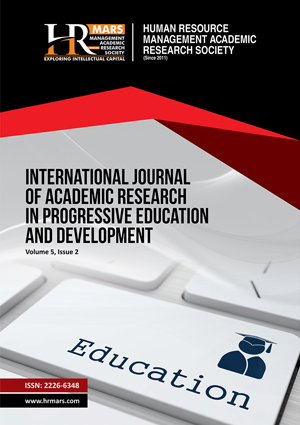
ISSN: 2226-6348
Open access
This research was carried out in the Pekanbaru city, Riau Province, Indonesia. The aim of this research is to see whether there is a correlation between thought styles and student achievement in Arabic classes. A questionnaire would be used to gather answers from 150 students at Riau Islamic University's Faculty of Islam's Department of Islamic Education. This reduction in achievement is a crucial indication of the need to develop teaching and learning methods in the classroom, which cover academic, social, and behavioral elements. Student accomplishments, as well as steps to improve student engagement, inspiration, and success, must be addressed right away. This indicates that personality distinctions and student abilities are less essential. Teachers have their own thought styles without considering the correlations of student cognitive styles, where thinking styles and learning are the outcomes of teachers' and students' mental styles. The secret to thinking style and success in the classroom is each specific teacher's and student's thinking style. The Sternberg-Wagner (1997) Thought Style Inventory was used to assess the thinking types of the students in this sample. To describe the respondent's profile and to address study questions, descriptive statistical analysis was used to measure the mean and standard deviation. Monarchical, Oligarchic, Global, Local, External, and Conservative thought patterns can be shown to be the most prevalent in the study. It suggests that the prevailing thought method is the one that is seen the most in the class. The understanding is that Sternberg's thought style is also not being used optimally in the classroom because students and teachers do not completely comprehend each individual's thinking style, necessitating fertilization in order to harmonies the teaching and learning thinking styles. According to the importance of the local thinking style's reliability, the inferior correlation value is quite prevalent, indicating that the local thinking style is the most commonly utilized in the class among the prevailing thinking styles.
Albrecht. (1983). Organization Development: A Total Systems Approach to Positive Change in Any Business Organization. Englewood Cliffs. New Jersey: Prentice Hall.
Almulla, M. (2017). An investigation of Cooperative Learning in a Saudi high school: A case study on teachers’ and students’ perceptions and classroom practices. Thesis Doctoral of Philosophy. University of Leicester.
AlKhamisi, K. M. (2019). Exploring Teachers’ and Students’ Perspectives On The Use Of Arabic Language In Grades 11-12 Efl Classrooms In Oman: An In-Depth Investigation Of Efl Pedagogy. Thesis Doctor of Philosophy. University of Southern Queesland. Australia.
Debono, E. (2018). Future Positive: Change Your Mind set for a Positive Future. Publisher Random House UK. ISBN: 9781785041099.
Gaur, A. S., & Gaur, S. S. (2009). Statistical Methods for Practice and Research: A Guide to Data Analysis Using SPSS. India. Second Edition. SAGE Publications. ISBN: 8132101006
Halim, L., Osman, O., & Iksan, Z. (2002). Laporan Penyelidikan Jangka Pendek. Fakulti Pendidikan. Universiti Kebangsaan Malaysia.
Krejcie, R. V., & Morgan, D. W. (1970). Determining Sample Size for Research Activities. Educational and Psychological Measurement, 30 (3), 607–610. doi:10.1177/001316447003000308.
Maree, J. G., and De Boer, A. L. (2003). Assessment of Thinking Style Preferences And Language Proficiency For South African Students Whose Natrve Languages Differ. Pjychological Reports, 2003,93,449-457. Universify Of Pretoria.
Meerah, T. S. M. (2009). Teacher’s behavior and knowledge for enhancing student’s achievement. Dlm. Onno De Jong & Lilia Halim. (Penyt), Teachers’ Professional Knowledge in Science and Mathematics Education: Views from Malaysia and Abroad, (hlm. 141-166). Bangi: Universiti Kebangsaan Malaysia.
Omar, H. (2006). Perkaitan antara stail berfikir dan stail belajar dengan pencapaian dan daya saing pelajar MRSM. Tesis Doktor Falsafah. Fakulti Pendidikan. UKM
Slavin, R. E. (2006). Educational Psychology: Theory and Practice (8th ed.). Boston: Pearson
Spearman, C. (1927). The abilities of man. New York: Macmillan
Sternberg, R. J. (1997). Thinking Styles. New York: Cambridge Universiti Press
In-Text Citation: (Hayati et al., 2021)
To Cite this Article: Hayati, N., Surat, S., & Noer, M. A. (2021). The Relationship Between Student Academic Achievements and Their Thinking Style. International Journal of Academic Research in Progressive Education and Development, 10(2), 79-88.
Copyright: © 2021 The Author(s)
Published by HRMARS (www.hrmars.com)
This article is published under the Creative Commons Attribution (CC BY 4.0) license. Anyone may reproduce, distribute, translate and create derivative works of this article (for both commercial and non-commercial purposes), subject to full attribution to the original publication and authors. The full terms of this license may be seen at: http://creativecommons.org/licences/by/4.0/legalcode